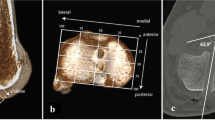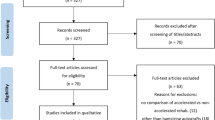Abstract
Purpose
The purpose of this study was to verify the efficacy of a novel technique for additional tying on the adjustable-loop device to prevent stress concentration on the graft loop end and gradual loop lengthening.
Methods
A total of 124 patients who underwent anterior cruciate ligament reconstruction using hamstring autografts from 2014 to 2017 were included in this retrospective study. After 1:1 propensity score matching, two groups were formed (group I: 50 patients without tying vs. group II: 50 patients with tying). Anterior laxity was evaluated using side-to-side differences. Tunnel length, loop length, and graft-tunnel gap were measured using follow-up magnetic resonance imaging. The signal-to-noise ratio was calculated at the loop end, loop inner side, tunnel entrance, and graft mid-substance. The clinical outcomes were assessed using the International Knee Documentation Committee score, Lysholm score, pivot shift test, and Lachman test.
Results
The average follow-up period was 63.2 ± 4.8 and 53.8 ± 11.9 months in groups I and II, respectively. Anterior laxity showed that side-to-side differences improved significantly 6 months postoperatively in both the groups. Although the anterior laxity improved in group II (2.9 ± 1.0 to 1.6 ± 0.8, p < 0.001), it deteriorated in group I (2.5 ± 1.5 to 3.3 ± 1.3 mm, p < 0.001) at the final follow-up. The graft-tunnel gap was significantly larger in group I (p < 0.001). The signal-to-noise ratios of the loop end and loop inner side were significantly higher in group I (p < 0.001 and p = 0.020, respectively). The clinical outcomes at the final follow-up were not significantly different between the groups.
Conclusion
The additional tying on the adjustable-loop device was not superior to the control group in clinical stability examination or outcome. However, it was effective in anterior laxity measured by stress radiographs, preventing stress on the adjustable-loop device, and gradual graft loop lengthening.
Level of evidence
Level III.




Similar content being viewed by others
Abbreviations
- ALD:
-
Adjustable-loop device
- SNR:
-
Signal-to-noise ratio
- ACLR:
-
Anterior cruciate ligament reconstruction
- BMI:
-
Body mass index
- MRI:
-
Magnetic resonance imaging
- DICOM:
-
Digital image communication in medicine
- ROI:
-
Region of interest
- IKDC:
-
International Knee Documentation Committee
- ANOVA:
-
Analysis of variance
- ICC:
-
Intra-class correlation coefficient
References
Ahn HW, Seon JK, Song EK, Park CJ, Lim HA (2019) Comparison of clinical and radiologic outcomes and second-look arthroscopic findings after anterior cruciate ligament reconstruction using fixed and adjustable loop cortical suspension devices. Arthroscopy 35:1736–1742
Ahn JH, Ko TS, Lee YS, Jeong HJ, Park JK (2018) Magnetic resonance imaging and clinical results of outside-in anterior cruciate ligament reconstruction: a comparison of fixed-and adjustable-length loop cortical fixation. Clin Orthop Surg 10:157. https://doi.org/10.4055/cios.2018.10.2.157
Ahn JH, Lee SH, Choi SH, Lim TK (2010) Magnetic resonance imaging evaluation of anterior cruciate ligament reconstruction using quadrupled hamstring tendon autografts: comparison of remnant bundle preservation and standard technique. Am J Sports Med 38:1768–1777
Ahn JH, Lee YS, Jeong HJ, Park JH, Cho Y, Kim K-J et al (2017) Comparison of transtibial and retrograde outside-in techniques of anterior cruciate ligament reconstruction in terms of graft nature and clinical outcomes: a case control study using 3T MRI. Arch Orthop Trauma Surg 137:357–365
Aydin D, Ozcan M (2016) Evaluation and comparison of clinical results of femoral fixation devices in arthroscopic anterior cruciate ligament reconstruction. Knee 23:227–232
Balldin BC, Nuelle CW, DeBerardino TM (2020) Is intraoperative fluoroscopy necessary to confirm device position for femoral-sided cortical suspensory fixation during anterior cruciate ligament reconstruction? J Knee Surg 33:265–269
Barrow AE, Pilia M, Guda T, Kadrmas WR, Burns TC (2014) Femoral suspension devices for anterior cruciate ligament reconstruction: do adjustable loops lengthen? Am J Sports Med 42:343–349
Cheng J, Paluvadi SV, Lee S, Yoo S, Song E-K, Seon J-K (2018) Biomechanical comparisons of current suspensory fixation devices for anterior cruciate ligament reconstruction. Int Orthop 42:1291–1296
Choi HG, Kim JS, Jung YS, Yoo HJ, Lee YS (2021) Prediction and development of preventive strategies for lateral hinge fracture during opening wedge high Tibial osteotomy based on osteotomy configurations. Am J Sports Med 49:2942–2954
Choi N-H, Park T-H, Oh W-K, Victoroff BN (2019) Radiologic and clinical outcomes after hamstring anterior cruciate ligament reconstruction using an adjustable-loop cortical suspension device with retensioning and knot tying. Arthroscopy 35:2629–2633
Choi SH, Ha JK, Dal Jae Jun JGS, Park JH (2017) Additional post-tie for unstable femoral suspensory fixation during anterior cruciate ligament reconstruction using TightRope® RT: clinical reports on 3 cases. Arthrosc Orthop Sports Med 4:34–38
Fu C-W, Chen W-C, Lu Y-C (2020) Is all-inside with suspensory cortical button fixation a superior technique for anterior cruciate ligament reconstruction surgery? A systematic review and meta-analysis. BMC Musculoskelet Disord 21:1–3. https://doi.org/10.1186/s12891-020-03471-3
Janssen RP, van der Wijk J, Fiedler A, Schmidt T, Sala HA, Scheffler SU (2011) Remodelling of human hamstring autografts after anterior cruciate ligament reconstruction. Knee Surg Sports Traumatol Arthrosc 19:1299–1306
Jiang D, Ao Y-f, Jiao C, Guo Q-w, Xie X, Zhao F et al (2019) The effect of cyclic knee motion on the elongation of four-strand hamstring autograft in anterior cruciate ligament reconstruction: an in-situ pilot study. BMC Musculoskelet Disord 20:1–8. https://doi.org/10.1186/s12891-019-2699-5
Johnson JS, Smith SD, LaPrade CM, Turnbull TL, LaPrade RF, Wijdicks CA (2015) A biomechanical comparison of femoral cortical suspension devices for soft tissue anterior cruciate ligament reconstruction under high loads. Am J Sports Med 43:154–160
Kanamura H, Arai Y, Hara K, Takahashi T, Ikoma K, Fujiwara H et al (2016) Quantitative evaluation of revascularization at bone tunnels and grafts with contrast-enhanced magnetic resonance angiography after anterior cruciate ligament reconstruction. Int Orthop 40:1531–1536
Kane LT, Fang T, Galetta MS, Goyal DK, Nicholson KJ, Kepler CK et al (2020) Propensity score matching: a statistical method. Clin Spine Surg 33:120–122
Kang SG, Lee YS (2017) Arthroscopic control for safe and secure seating of suspensory devices for femoral fixation in anterior cruciate ligament reconstruction using three different techniques. Knee Surg Relat Res 29:33
Kim JS, Lee JI, Choi HG, Yoo HJ, Jung YS, Lee YS (2021) Retro-tubercle biplanar opening wedge high Tibial osteotomy is favorable for the patellofemoral joint but not for the osteotomized tubercle itself compared with supra-tubercle osteotomy. Arthroscopy 37:2567–2578
Kim TW, Lee JI, Choi HG, Yoo HJ, Kim KT, Lee YS (2021) Comparison of the radiologic, morphometric, and clinical outcomes between kinematically and mechanically aligned total knee arthroplasty: a propensity matching study. J Knee Surg. https://doi.org/10.1055/s-0041-1725006
Lamoria R, Sharma A, Goyal D, Upadhyay R (2020) Influence of three different fixation methods on femoral tunnel widening in ACL reconstructed patients evaluated using computed tomography (CT) scan. Eur J Orthop Surg Traumatol 30:411–417
Lee D-H, Son D-W, Seo Y-R, Lee I-G (2020) Comparison of femoral tunnel widening after anterior cruciate ligament reconstruction using cortical button fixation versus transfemoral cross-pin fixation: a systematic review and meta-analysis. Knee Surg Relat Res 32:1–8. https://doi.org/10.1186/s43019-020-0028-9
Lee DW, Shim JC, Yang SJ, Cho SI, Kim JG (2019) Functional effects of single semitendinosus tendon harvesting in anatomic anterior cruciate ligament reconstruction: comparison of single versus dual hamstring harvesting. Clin Orthop Surg 11:60–72
Lee O-S, Lee YS (2020) Changes in hamstring strength after anterior cruciate ligament reconstruction with hamstring autograft and posterior cruciate ligament reconstruction with tibialis allograft. Knee Surg Relat Res 32:1–9. https://doi.org/10.1186/s43019-020-00047-2
Lee YS, Han SH, Jo J, Kwak K-s, Nha KW, Kim JH (2011) Comparison of 5 different methods for measuring stress radiographs to improve reproducibility during the evaluation of knee instability. Am J Sports Med 39:1275–1281
Lutz PM, Achtnich A, Schütte V, Woertler K, Imhoff AB, Willinger LJ (2021) Anterior cruciate ligament autograft maturation on sequential postoperative MRI is not correlated with clinical outcome and anterior knee stability. Knee Surg Sports Traumatol Arthrosc. https://doi.org/10.1007/s00167-021-06777-4
Mae T, Shino K, Yoneda K, Tachibana Y, Ohori T, Yoshikawa H et al (2020) Residual graft tension after graft fixation in anterior cruciate ligament reconstruction: manual vs tensioning boot techniques. J Orthop Sci 25:1061–1066
Mayr HO, Stoehr A, Herberger KT, Haasters F, Bernstein A, Schmal H et al (2021) Histomorphological alterations of human anterior cruciate ligament grafts during mid-term and long-term remodeling. Orthop Surg 13:314–320
Pacull R, Kalk E, Rongieras F, Bertani A, Gras L-L (2021) Anterior cruciate ligament reconstruction with short hamstring grafts: the choice of femoral fixation device matters in controlling overall lengthening. Knee Surg Sports Traumatol Arthrosc. https://doi.org/10.1007/s00167-021-06783-6
Petre BM, Smith SD, Jansson KS, de Meijer P-P, Hackett TR, LaPrade RF et al (2013) Femoral cortical suspension devices for soft tissue anterior cruciate ligament reconstruction: a comparative biomechanical study. Am J Sports Med 41:416–422
Terauchi R, Arai Y, Hara K, Minami G, Nakagawa S, Takahashi T et al (2016) Magnetic resonance angiography evaluation of the bone tunnel and graft following ACL reconstruction with a hamstring tendon autograft. Knee Surg Sports Traumatol Arthrosc 24:169–175
Whitaker S, Edwards JH, Guy S, Ingham E, Herbert A (2019) Stratifying the mechanical performance of a decellularized xenogeneic tendon graft for anterior cruciate ligament reconstruction as a function of graft diameter: an animal study. Bone Jt Res 8:518–525
Williams BA, Gil J, Farmer KW (2019) Late migration of an adjustable-loop cortical suspension device in anterior cruciate ligament reconstruction. Case Rep Orthop. https://doi.org/10.1155/2019/1061385
Author information
Authors and Affiliations
Contributions
HGC and HWJ participated in study design and drafted the manuscript, HGC performed the statistical analysis, SBP and SJS collected the data and contributed to performing statistical analysis, YSL conceived of the study, participated in coordination and helped to draft the manuscript. All authors read and approved the final manuscript.
Corresponding author
Ethics declarations
Conflict of interest
The authors declare that we have no conflict of interest.
Funding
N/A.
Ethical approval
Institutional Review Board approval was obtained before performing the study (B-2012-652-108).
Informed consent
N/A.
Additional information
Publisher's Note
Springer Nature remains neutral with regard to jurisdictional claims in published maps and institutional affiliations.
Rights and permissions
About this article
Cite this article
Choi, H.G., Jeong, H.W., Park, S.B. et al. Additional tying on the adjustable-loop device improves the outcomes of anterior cruciate ligament reconstruction using hamstring autograft. Knee Surg Sports Traumatol Arthrosc 30, 3673–3680 (2022). https://doi.org/10.1007/s00167-022-06936-1
Received:
Accepted:
Published:
Issue Date:
DOI: https://doi.org/10.1007/s00167-022-06936-1




